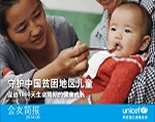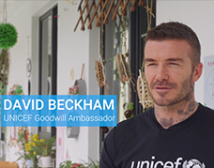BEIJING, 6 May 2015– As part of the global action to mark the third UN Global Road Safety Week (May 4-10), UNICEF calls attention to be paid to improving safety for children to reduce road accident related deaths.
Road traffic injury is a leading killer of school-age children and adolescents globally and affects developing countries in particular, which account for 90% of the casualties on the world's roads. Worldwide, it is the number one killer of young people aged 15-29; the leading cause of death for boys aged 5-14; and a top five killer of girls aged 5 and over.
Every year in China, over 10 million children are injured, and nearly 60,000 children die because of drowning, traffic accidents, accidental suffocation, falls, poisoning and other accidents. Injuries, including road traffic accidents, are now the third most important cause of death in children under five after newborn and infectious causes in China, according to China's Maternal and Child Mortality Surveillance System (2013). For children 1-4 years of age road traffic accidents are the leading mortality cause. In 2013, according to the Ministry of Public Security, 3,994 children under 18 died on the roads because of accidents, and 17,955 were injured. Two UNICEF child injury surveys in Beijing (2004) and Jiangxi (2007) found that for every child death due to injury, two to three children were permanently disabled, around 50 children were hospitalized for more than 10 days, and more than 250 children sought care or missed a day out of school.
To highlight the plight of children on the roads and generate actions to better ensure their safety, the UN Global Road Safety Week, the third of its kind, has ‘Road Safety for Children' as this year's theme. The campaign asks people to sign a Children's Declaration on Road Safety online, calling upon decision-makers worldwide to take action and protect children.
“With improved road safety regulation and enforcement, we can avoid this terrible loss of life that exacts a heavy toll on families and society as a whole,” said Dr. Robert Scherpbier, Chief of Health, Nutrition and WASH at UNICEF China. “2015 is a pivotal year, as global leaders will launch a new set of global goals for future development in September. UNICEF is working with partners to have halving road traffic fatalities included in the Sustainable Development Goals, so as to make road safety one of the priorities of the post-2015 global development agenda.”
As part of an advocacy campaign to mark the UN Global Road Safety Week, a high-profile seminar on child road safety will be hosted by the Government of China with support from UNICEF and other partners. A new report on child road safety, jointly compiled by the Ministry of Public Security and the Chinese Center for Disease Control and Prevention, will be released at the seminar, while a group of primary school students will add Chinese children's call for action on road safety, which was adapted from a global version of a child declaration and tailored to China's specific situation.
For countries in a phase of rapid motorization – many of them middle-income countries – roads are often built without due consideration for the communities they pass through. A shift in mind-set is needed to ensure that roads everywhere serve the needs of and are safe for all who use them, including children, but also other vulnerable groups such as pedestrians, cyclists and motorcyclists.
According to a global WHO study, of all the children injured or killed on the roads worldwide each year, 38% are pedestrians. In the low- and middle-income countries where these fatalities most often occur, children walk along roads where there is a mixture of different modes of transport – some moving at high speed – and where infrastructure such as sidewalks, cross walks and safety barriers is lacking. Children who travel by car make up another 36% of those killed. Most of these children are from high-income countries. They are at greater risk both in the front and the back seat of a vehicle when they are unrestrained. The remainder of the children who are killed on the roads each year travel by bicycle or motorcycle, often without helmets, or are drivers themselves.
The Global Plan for the Decade of Action for Road Safety 2011– 2020, adopted by the UN, highlights what's needed to improve road safety for everyone. For governments, this includes legislating around key risks such as speeding, drinking and driving, helmets, seat-belts, and child restraints and enforcing the laws in place; building roads and obliging manufacturers to produce vehicles with appropriate safety features; and having systems in place to provide prompt emergency care for the injured.
UNICEF is also calling upon China's legislating on child restraints and enforcing the law in place; introducing school safety zones which include a package of speed reduction measures, car-free zones, safe drop-off and pick-up points; designating play areas for children away from the road; as well as the use of qualified school buses, especially for rural children.
In response to this man-made epidemic, UNICEF has launched a new partnership to collaborate on child road traffic injury prevention worldwide. The partnership with the FIA Foundation, a philanthropy focused on global road safety, sets out to develop and initiate a first phase of UNICEF's global response to the growing rates of road traffic injuries and fatalities among children and adolescents in fast developing regions of the world.
In China, UNICEF will work on development of a national strategy on child road traffic injury prevention with Government and partners, including around data building and analysis and in developing a pilot work plan for pedestrian safety on the route to school.
To sign on the Child Declaration, please visit: savekidslives2015.org
About UNICEF: UNICEF promotes the rights and wellbeing of every child, in everything we do. Together with our partners, we work in 190 countries and territories to translate that commitment into practical action, focusing special effort on reaching the most vulnerable and excluded children, to the benefit of all children, everywhere. For more information about UNICEF and its work visit: www.unicef.org
Visit UNICEF China website: www.unicef.cn
Follow us: Sina Weibohttp://weibo.com/unicefchina Tecent Weibo http://t.qq.com/unicef
Wechat: unicefchina
For further information, please contact: Shantha Bloemen, UNICEF China, +8610 85312610, sbloemen@unicef.orgor Liu Li, UNICEF China, +8610 85312612, liliu@unicef.org




























